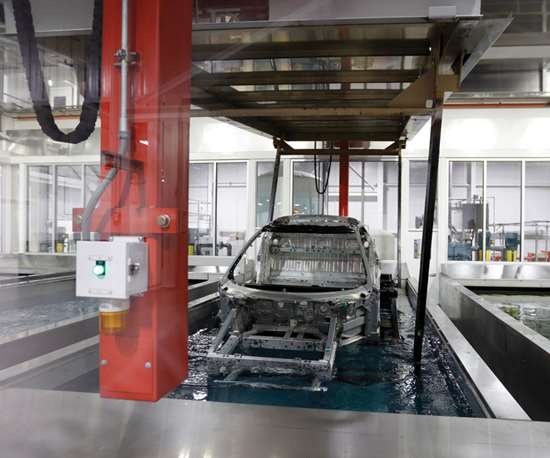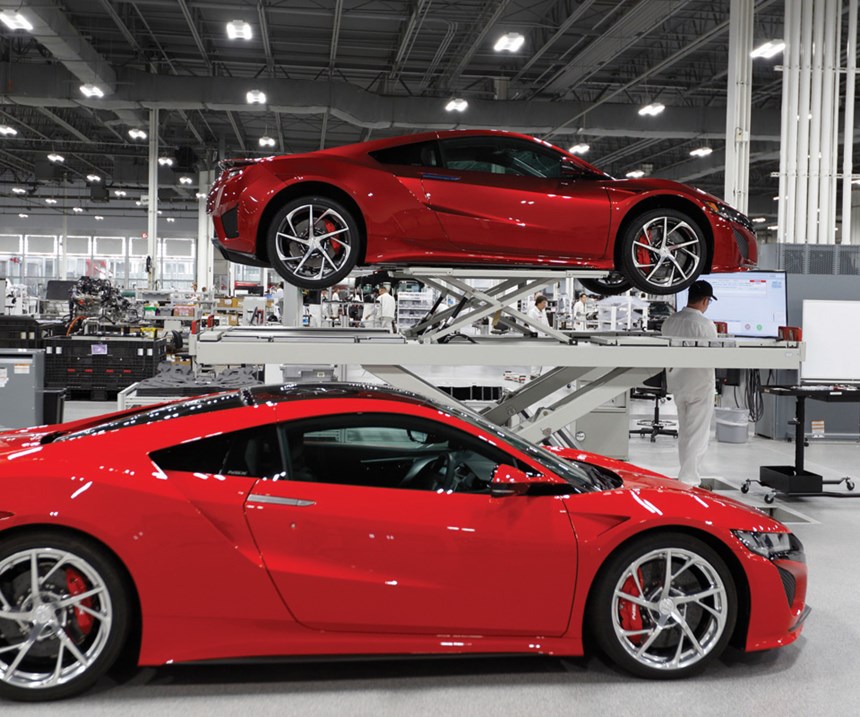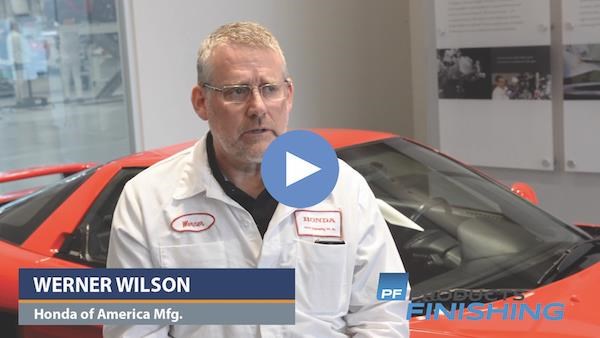Supercar Gets Super Ecoat System
Honda builds unique ecoat system for Acura NSX at $70 million Performance Manufacturing Center.
#masking #measurement-testing #automotive
From a purely aesthetic perspective, no one will ever confuse the Ohio town of Marysville with the Italian ports of Sant’Agata Bolognese or Maranello.
But from an automotive engineering standpoint, the quaint town of Marysville—home of Honda America’s manufacturing facility and the adjacent Performance Manufacturing Center (PMC)—can compete quite well with the Italian cities, which produce Lamborghinis and Ferraris, respectively.
Featured Content
One step inside the $70 million Performance Manufacturing Center—where the Acura NSX supercar is assembled from scratch by technicians in lab coats—and one immediately gets the sense of craftsmanship, acceleration and performance all at once.
“It is a very special automobile,” says Honda’s Werner Wilson, Production Strategy and Development Block for the New Model/New Technology Division for Honda Engineering North America. “Each car is built to order. We can build up to eight cars a day.”
Built in the 206,000-square-foot PMC assembly plant, the Acura NSX starts at around $156,000 for a base model. It is crafted and bolted together by more than 100 technicians, often in front of the car’s owner themselves who can tour the plant. The vehicle undergoes a 20-hour paint and coating process that includes a one-of-a-kind electrocoating system.
Different Electrocoat Approach
The assembly process includes 22 stations that take about 14 hours. It starts with assembling the multi-material space frame by robotic MIG welding, which Acura says is an automobile industry first. The aluminum space frame of the NSX gets welded to three pieces of ultra-high-strength steel in the roof rails and windshield header for added protection. That is followed by the robotic tooling of the NSX’s inner and outer hood, door and hatch panels.
The NSX then gets sent to the unique glass-enclosed ecoat line, where it starts the process of corrosion protection and ends with a brilliant coating of paints such as curva red, berlina black or 130R white, all applied and finished by hand.
While most automotive assembly plants hide their ecoat operations, Acura took a significantly different approach.
The ecoat line—constructed by Therma-Tron-X, Inc. in Sturgeon Bay, Wisconsin—is a marvel in efficiency and engineering, and the highlight of most tours throughout the facility.
“This plant was built for tours, so we wanted the ecoat line to basically be built in a glass box,” Wilson says. “We are very big on customer experience, and we bring people through the facility and let them see all that is happening. Every part of this plant was built with the customer in mind.”
Wilson was the paint technical leader at the PMC before recently being reassigned. He teamed with co-worker Randy Cool to help design the ecoat system to showcase its manufacturing value, as well as its intrigue to those who may not know what is occurring when the car goes through the tanks.
“It was built to be on display,” Wilson says. “Other plants’ ecoat lines are pretty dark and steamy, and not very attractive to look at. But we wanted to do something different.”
The Honda team spoke with several ecoat integrators to explain how they wanted the system to be designed and displayed for all to see. Some companies had trouble trying to meet that requirement.
“TTX understood what we wanted,” Wilson says.
10-Tank Ecoat System
The ecoat system is designed with 10 process tanks, the first with a pretreatment cleaner and then two water bath rinses before heading into a zirconium dip tank. Honda chose to ecoat the frames in black, especially as they do not paint the frame afterwards. The ecoat process ends with three ovens that bake the primer for 50 minutes at roughly 390°F.
“From an appearance standpoint, the black frame just looks so much better,” says Wilson, who added that the NSX’s spaceframe design allows the body to be put on after they build the car.
“We try to put the body of the car on as late as possible since it makes the car a lot easier to build, and it prevents damage,” he says.
And with a car like the NSX, sending it out in pristine condition is the name of the game to match its motoring performance.
Originally made in Japan in 1990, Acura ceased production in 2005. In 2012, it was announced the car would make a comeback, but would be built in Marysville.
“Our R&D facility is just down the road from the Marysville plant, so it was great to have everything here in such close proximity,” says Stacey Koons, communications specialist for the PMC. “Our company has been here for over 30 years, so you have such a great workforce of knowledge existing already. We could tap into people who really know how to put a plant and our processes together.”
The Acura NSX comes with a Sport Hybrid Power Unit that is engineered to produce 573 horsepower and 476 lb.-ft. of torque, with a top speed of 191 miles per hour. The 3.5-liter twin turbo V-6 comes with a nine-speed dual clutch transmission; first gear is for launch and ninth is for cruising with the seven gears in between in close ratio.
Heart of the Beast: 0-to-60 in Three Seconds
Honda calls its engine the “heart of the beast”—it can go from 0 to 60 mph in 3 seconds—but also says it is an absolute game-changer in supercar performance.
They say the engine power and direct electric torque mean not only a new kind of dynamic automotive performance in acceleration, but also in how the NSX steers and brakes, as well.
The design of the NSX is also painstakingly engineered. Acura engineers say the car’s visual allure is the compilation of thousands of hours of “computational fluid dynamics” and wind tunnel analyses that resulted in three times the downforce at the rear of the NSX as it is at the front, which they say provides an ultimate balance that promises great handling and performance.
But Acura also uses that aerodynamic to its advantage, too, by “reintroducing” the air that flows over and around the NSX for thermal cooling purposes in the front and rear power unit components, brakes and other systems, a process they call “Total Airflow Management.”
“The NSX is a visual expression of beautiful design and performance working together,” says Michelle Christensen, Acura’s large project leader for design.
Following the ecoat primer, each car is taken to a sealing station, where the frame is examined and technicians apply sealant to reduce noise and prevent dust. It’s a two-hour process that involves special fluorescent lighting and ends with the car going back into an oven for a 30-minute cure.
High-End Paints Complete Finish
Each NSX is then hand-carted to the paint area, where it undergoes 11 coats of finish, including another primer, five coats of a base paint and four layers of a clear coat. Dürr paint robots apply coatings to the body panels, while the front grill is taken aside and hand-sprayed in a color Acura calls “piano black.”
“We use very high-end paint,” Wilson says. “Two of our optional colors cost an additional $6,000. This requires extremely high quality coatings.”
After curing, each NSX is inspected with soft leather gloves to find any blemish that might not meet the standard of perfection, and laser examined to guarantee a top-quality finish. From beginning to end, the NSX is checked at 2,700 markers along the way.
“Length-wise, the paint process is one of the longest processes in building the car,” says Koons. “Applying and curing all of that paint takes quite a long time; it’s about 10 hours over two days.”
Wilson says the wet-on-wet painting process for the 11 coats is effective, but great care needs to be taken.
“It can be a dangerous process because that’s a lot of paint being applied in a short amount of time,” he says. “You can get some sagging because you have a lot of wet paint trying to hook onto each other.”
Fortunately, quality inspections along the way ensure that the Acura NSX heads out the door with a brilliant paint scheme, starting with a unique ecoat process that must be seen to be admired, and finishing with a beautiful final covering.
“We know that NSX owners have very discerning taste, so we went out of our way to make sure that the way we finished these cars is very unique and special,” says Koons.
The technicians who assemble the car and oversee the finish are a group hand-selected from other Honda plants. Koons says they can apply to work at the PMC, and are strenuously tested before getting a prime position building the NSX.
“I say it’s one of the best finishes you will ever see on a car,” Wilson says, the bias evident in his voice but the proof being in the car that drives out of the PMC. “It takes a lot of time and a lot of materials, but you can judge the finish yourself. It’s as good as any in the world.”
For information on Honda of America, please visit ohio.honda.com; for Therma-Tron-X, visit ttxinc.com; for Dürr, visit durr-northamerica.com.
Originally published in the July 2017 issue.
RELATED CONTENT
-
Applications Innovation Leads to Better Masking Solutions
When masking product failures are costing you money, it pays to work with an expert that can select or engineer the most efficient solution.
-
What is Electrocoating?
E-coat can produce uniform finishes with excellent coverage and outstanding corrosion resistance.
-
8 Things You Need to Know About Paint Booth Lighting
Global Finishing Solutions has come up with some helpful insights on lighting for paints booths which plays a crucial role in achieving a quality paint job.
























